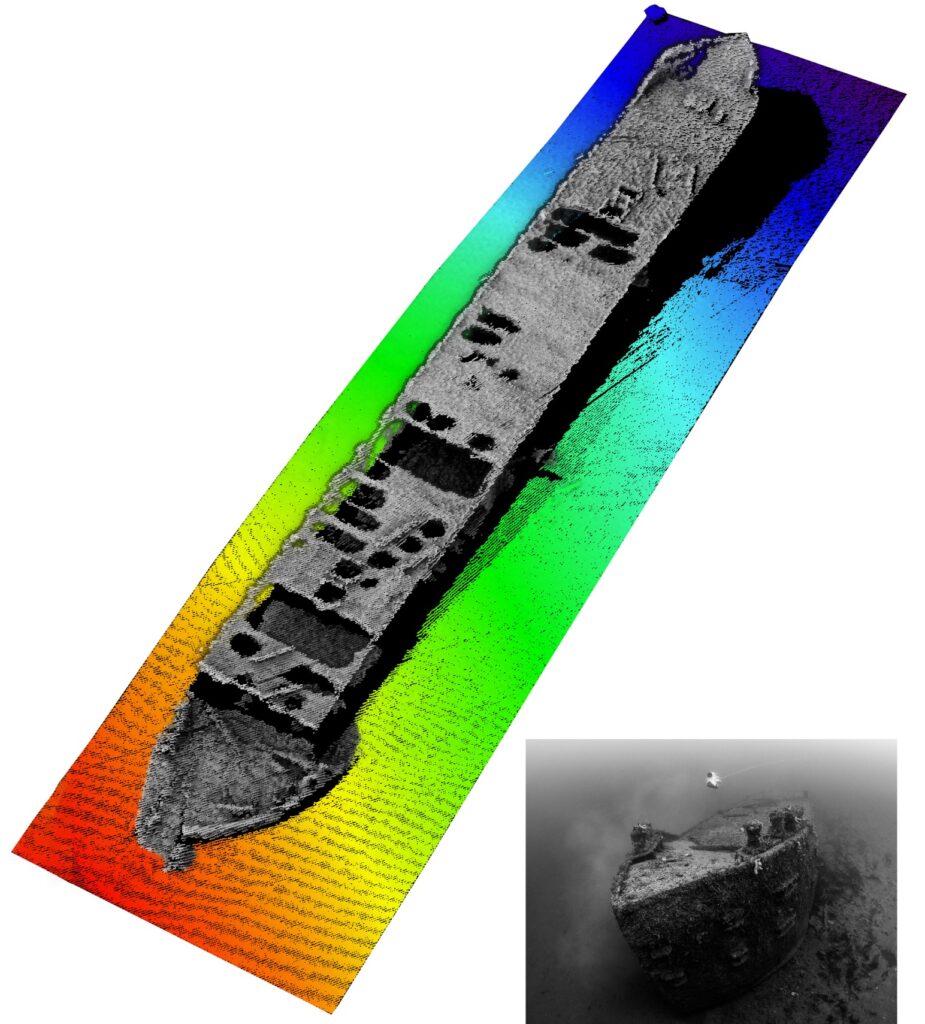Links:
Introduction
- This case study highlights the key features of the NORBIT WINGHEAD i80S Long Range multibeam sonar mapping system.
- A 4.5km2 area was surveyed across a wide range of depths, from 5m to 340m, in the diverse and challenging environment of the Trondheim Fjord in Norway.
- The results demonstrate the sonar’s versatile capabilities, delivering high-resolution data with wide swath coverage in a range of underwater environments.
- Equipment used:
- NORBIT WINGHEAD i80S Long Range, featuring integrated Applanix OceanMaster GNSS/INS and integrated SV sensor.
- NORBIT Sound Velocity Profiler
- NORBIT PORTUS Pole
WINGHEAD i80S Long Range Multibeam Sonar
The WINGHEAD i80S Long Range is a compact, fully integrated multibeam survey system offering 0.5×0.9° beam widths at 400kHz and 1.0×1.8° at 200kHz
- The Echo sounder is frequency agile from 200-700kHz
- It generates 1024 dynamically focused beams per ping.
- üUp to 600m range performance.
- The IMU is tightly embedded within the sonar head.
- üNORBIT’s steerable transmission technology provides full motion stabilisation (roll, pitch and yaw) to ensure uniform sounding coverage in dynamic sea states.
- Dual Swath provides up to 2048 beams, allowing higher sounding density and reduced survey time.
- The system weighs 8.0kg in air and connects to a compact topside unit via a single cable, allowing rapid mobilisation.
Installation
The sonar was mounted on NORBIT’s vessel, MARMEL, using the NORBIT PORTUS mounting pole.
- The sonar’s compact size allowed for easy transportation to the vessel, as the entire system, including cable, conveniently fits into a single Pelican Case.
- The single-cable solution enabled rapid mobilisation, allowing the system to be quickly deployed and operational within minutes.
- The fixed and known offsets of the NORBIT PORTUS pole, combined with the wizard-based INS setup tools in the NORBIT GUI, ensured a quick and easy setup.
- The streamlined installation process simplifies the learning curve for less experienced surveyors, minimising complexity and reducing the risk of operator error.
Results: Range Performance
The sonar excels at long-range detection, enabling wide swath coverage in deep waters.
- The sonar transmits longer pulses in deep waters, providing optimal swath performance and significantly increasing coverage area.
- Coverage greater than 2x water depth was achieved at 300m with an operating frequency of 200kHz.
- The frequency and pulse characteristics can be changed to suit different survey needs, providing versatility for both shallow water and deep-water operations without sacrificing data quality.
Results: Shallow Water Target Detection
The sonar can also operate at 700kHz, producing narrower beams (less than 0.3deg) for ultra-high resolution target mapping in shallow water.
As part of the product development, NORBIT has implemented new and improved detection algorithms to provide cleaner and more repeatable data with lower uncertainty.
This example shows 700kHz raw point cloud data of a sunken barge, measuring 20m in length, situated in 15m water depth.
Results: Deep Water Target Detection
This 700kHz point cloud data shows a Short Sunderland seaplane surveyed at a depth of 67m. It has rested at the bottom of the fjord since 1945 and measures 26m in length, with a wingspan of 36m.

Results: Deep Water Target Detection
This stormwater line, measuring 56cm in diameter, is clearly visible on the 1m DTM at a depth of 70m. The data was collected with 400kHz.

Results: Dual Swath
- Dual Swath enables the system to transmit multiple pings simultaneously, outputting 2x 1024 soundings.
- It can be used to increase along-track sounding density, or alternatively to increase survey speed while maintaining the same density as single swath.
- This example shows two lines, recorded with and without Dual Swath, in 60m water depth, gridded at 1.5m resolution. The same survey speed was used.
- The results show that, with Dual Swath enabled, more hits are achieved per grid cell, resulting in fewer coverage gaps when small bin sizes are used. This is particularly beneficial when the
vessel is subject to a lot of motion.
Results: Yaw Stabilisation
- Active yaw stabilisation compensates for natural changes in vessel heading, preventing gaps in coverage, and providing uniform sounding density in the outer beams.
- This allows the resulting data to be gridded with smaller bin sizes, reducing the need for additional infill, while satisfying the strict sounding density requirements often mandated by survey standards.
- The following example shows the raw point cloud outer beam data from the same line surveyed without (left) and with (right) yaw stabilisation:

Results: Backscatter
As well as bathymetry, the system can generate several imagery and backscatter outputs simultaneously (water column, snippets and sidescan)

Conclusions
The NORBIT WINGHEAD i80S Long Range is a versatile mapping system that delivers exceptional performance while maintaining the high standard of portability that NORBIT products are renowned for.
- Its single-cable solution and easy setup enable rapid deployment, reducing setup time and operational costs.
- Despite its small size, the system delivers high-resolution data and wide swath coverage across a range of depths, making it suitable for installations on platforms of all sizes, from ocean-going vessels to small USVs/ASVs.
- The integrated INS tools in the NORBIT software simplifies the software setup compared to traditional systems.
- The product offers a powerful, efficient, and user-friendly solution that meets the demands of modern hydrographic surveys.
For more information contact: [email protected]








